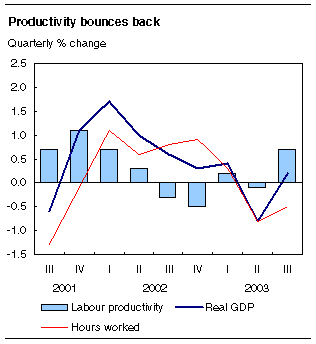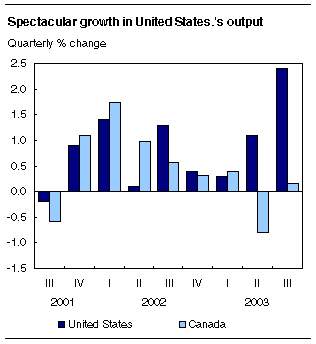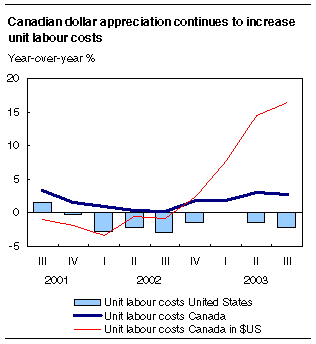
















 |
|
 |                |
Information identified as archived is provided for reference, research or recordkeeping purposes. It is not subject to the Government of Canada Web Standards and has not been altered or updated since it was archived. Please "contact us" to request a format other than those available.

|

Friday, December 12, 2003 Labour productivity, hourly compensation and unit labour costThird quarter 2003Labour productivity in Canada's business sector increased 0.7% in the third quarter compared with the second, the strongest quarterly gain in more than a year. This increase put an end to a lacklustre performance during the last five quarters, when productivity ranged between a gain of 0.3% and a decline of 0.5%. 
In the United States, the third-quarter growth in labour productivity was 2.1%, three times Canada's pace. However, this figure is still subject to revision. In returning to stronger productivity growth, Canadian businesses experienced a slight increase in economic activity, despite the huge power outage in Ontario in August. So far this year, economic activity in Canada has been affected by an exceptional combination of negative shocks. These included SARS, mad cow disease, the mid-August power blackout in Ontario, forest fires in British Columbia and the rising value of the Canadian dollar.
In the third quarter, businesses were able to increase their production slightly without hiring more workers. Better productivity performance in the United States largely the result of exceptional gain in productionThe much higher gain in productivity in the United States in the third quarter was due to its exceptional increase in economic output. In fact, during the second and third quarters, the gap in production growth between the two countries has remained high. In the second quarter, real gross domestic product rose 1.1% in the United States, compared with a 0.8% decline in Canada. In the third quarter, GDP south of the border rose a strong 2.4%, compared with a gain of 0.2% in Canada. The US gain was the highest quarterly increase since the first three months of 1984 (+2.7%). The growth in the United States was the result of several factors, including reductions in income tax, interest rates that were at an all-time low, and the weakness of the US dollar. In Canada, a decline in non-farm inventories of businesses, as well as the drop in exports, had a dampening effect on production growth. The exceptional third-quarter gain in production in the United States was accompanied by a slight improvement in the labour market. While the number of hours worked continued to decrease in Canada in the third quarter, the US business sector saw an end to the downturn in employment. While hours worked dropped 0.8% in the second quarter in Canada, they declined 0.5% in the third quarter. The number of hours worked in the third quarter was affected by the power outage that occurred in Ontario in August and the period of energy conservation that followed. Had it not been for this power outage, the number of hours worked would have dropped by only 0.3% instead of 0.5% in the third quarter. The power outage thus accounted for two-fifths of the decrease in hours worked in the business sector in the third quarter. 
In comparison, hours worked in US businesses increased 0.4 % in the third quarter, marking only the second increase in the past 14 quarters. These factors combined to produce lower productivity gains in Canada than in the United States during the third quarter. Productivity growth in the United States has been higher than in Canada since the second quarter of 2002. Higher Canadian dollar continues to drive labour costs in CanadaAmerican businesses also held a significant advantage over Canadian businesses with respect to changes in labour costs. On a year-to-year basis, unit labour costs in the third quarter increased 2.8% in Canada, but dropped 2.1% in the United States, as expressed in the respective currencies of each country. The gap in unit labour costs between Canada and the United States for the third quarter was the result of weaker growth in labour productivity in Canada, since the changes in hourly compensation were similar. Labour productivity in Canada increased scarcely 0.3% compared with the third quarter of 2002, while in the United States, productivity was up 5.0% on a year-over-year basis. 
Expressed in US dollars, the advantage for American businesses in terms of unit labour costs was even greater in the third quarter. With the 11.7% upsurge in the value of the Canadian dollar vis-à-vis its US counterpart between the third quarters of 2002 and 2003, the United States continues to hold a clear advantage in terms of the trend for unit costs. Unit labour costs for Canadian businesses, as measured in US currency, posted a spectacular increase of 16.4% annually in the third quarter, while those of American businesses recorded a drop of 2.1%. Available on CANSIM: tables 383-0008 and 383-0012. Definitions, data sources and methods: survey number 5042. A more comprehensive analysis, including additional charts and tables are now available in the Canadian economic accounts quarterly review (13-010-XIE, free). From the Our products and services page, under Browse our Internet publications, choose Free, then National accounts. For related product, see the new electronic publication Productivity Growth in Canada, 2003 (15-204-XIE, $37; 15-204-XPE, $49) that will be available soon. For more information on productivity growth, see the page Overview and description of publications in our site. The fourth quarter data for labour productivity, hourly compensation and unit labour cost will be released on March 12, 2004. For more information, or to enquire about the concepts, methods or data quality of this release, contact Jean-Pierre Maynard (613-951-3654; fax: 613-951-3292; maynard@statcan.gc.ca), Micro-Economic Analysis Division.
| |||||||||||||||||||||||||||||||||||||||||||||||||||||||||||||||||||||||||||||||||||||||||||||||||||||||||||||||||||||||||||||||||||||||||||||||||||||||||||||||||||||||||||||||||||||||||||||||||||||||||||||||||||||||||||||||||||||||||||||||||||||||||||||||||||||||||||||||||||||||||||||||||||||||||||||||||||||||||||||||||||||||||||||||||||||||||
|
|
|